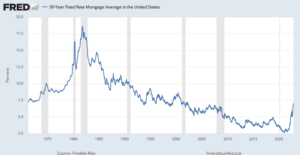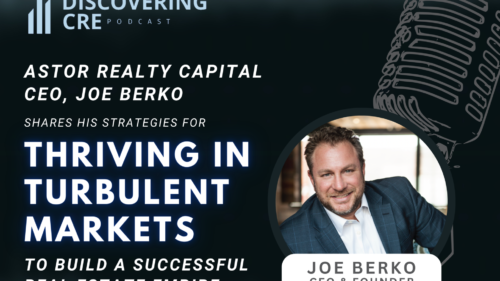CEO Joe Berko, summarizes our portfolio performance and talks market conditions in Q3 of 2022
November, 7 2022Q3 2022 LETTER TO OUR INVESTORS
Dear Friends, Investors and Partners,
Thank you for your continued trust in Astor’s operation. As we are in an advanced stage of a softening economy, this report will shed light on the impact of inflation, interest rates, supply chain, and labor markets and the effects these externalities have on our current portfolio. We conclude with Astor’s state of affairs and the steps we are taking to maintain the profitability of our portfolio which currently stands at $2.1 Billion in assets under management (AUM), 24 projects, and 3.5 million square feet in Seven States and Twelve MSAs. While we expect our profitability to be negatively impacted, our portfolio is still expected to generate a low 20’s% ROI (see attached Q3, Astor’s schedule of real estate Mark to Market).
Interest Rates
The Federal Reserve increased its target interest rate on November 2nd by 75 basis points, its “sixth rate hike of 2022 and fourth straight 0.75 percentage-point bump, bringing the fed-funds rate target range to 3.75% to 4.00%,” according to Barron’s. As a result of these policy decisions, we have seen interest rates more than double since the beginning of 2022.

We anticipate these rate increases will continue to have a negative effect on asset pricing and sales volume as banks offer lower loan amounts and potentially force borrowers to stay in their existing mortgages longer. Astor is factoring in a 15% overall drop in the values of condominiums, which could affect some of our projects, as we’re beginning to see slower sales activity at our developments on the Upper West Side of Manhattan and Brooklyn, NY.
On the flip side, several prominent voices are predicting that interest rates will drop very quickly as we progress into 2023 and the Fed shifts to fighting recessionary fears. Unfortunately, we do not have a crystal ball and will need to operate with worst-case expectations. The silver lining in this is that whenever we underwrite a condominium project at Astor, we require a viable rental fallback option as an alternate exit or hold scenario. Accordingly, our asset management team has been actively monitoring our developments closely. The majority are either close to full sellout (for example, our projects in Chicago and Boerum Hill) or are in a safe position to secure new mortgages which should allow them to sustain this slow-selling period.
The option of converting an asset to a rental property in order to preserve capital is always on the table and, although we are not there yet, we’re keeping our fingers on the pulse. The team is re-underwriting each project with fresh eyes and running a mark-to-market valuation to ensure that we’re not in any danger.
The Economy
Astor’s overall view of the market is cautionary. We’ve shifted our focus to seeking more preferred equity positions alongside our common equity originations and have been in advanced negotiations to launch a debt platform that will allow us to generate steady cash flow and attractive risk-adjusted returns through this volatile period. We feel that the environment is accretive for such a product at exactly this time and we’re excited to share more details on this in Q1.
Our existing projects, of which we have 24 in various stages from fully completed and stabilized to predevelopment, are doing well overall. Projects that we have seen costs rise have been mitigated by increases in rents, providing a reasonable equilibrium. Our asset management teams have rolled up their sleeves to assist our operating partners where necessary to ensure success. For example, we assisted in replacing an underperforming management company at an existing asset in Dallas while implementing more structure around the overall operations. At the same time, we’re already achieving our year 3 rent projections at the asset, allowing us to shift budget allocations to address other areas of need.
What Lies Ahead for Astor
On the originations front, Astor analyzes close to seven hundred (700) joint venture requests annually and approves 1.5% of the three billion ($3 billion) of real estate opportunities we see across our desk. In other words, we decline 98.5% of the opportunities we review. In recent months, we’ve tightened our underwriting criteria as we expect the bid-ask gap to narrow and align with the new pricing environment to reflects the higher cost of capital and to factor in the softening economy. Moreover, we anticipate an additional slowdown in new developments which in turn will ease demand for land and prices will adjust shortly after. Contractors will be more competitive in order to maintain their staff, which would help bring costs down further and provide a silver lining in our existing projects. The early signs are already showing, about a year ago, lumber, which represents a significant budgetary item was priced at $1,500 per linear foot; today it is trading for around $500 per linear foot.
While Astor will continue to take a disciplined and conservative approach with regard to investment of new opportunities, we will remain active across multiple asset classes targeting strong growth locations in Florida, Texas, New York metro, and Arizona, in addition to other selective MSAs. Our primary focus will continue to be multifamily and industrial projects that pencil out to today’s new world of yield, cost, and stress tests. Hospitality, office, retail, and condominiums will be considered on an extremely select basis when backed by a compelling story and top-tier development partners.
As always, we appreciate your continued support of Astor’s operation and hope you take comfort in knowing that we are confident in the long-term outcome of the real estate sector and our assets under management.
Joe Berko
CEO & Co-Founder, Astor Realty Capital








